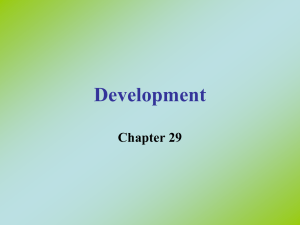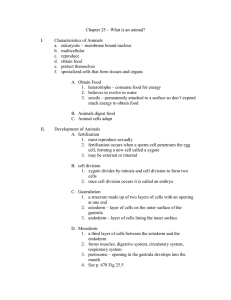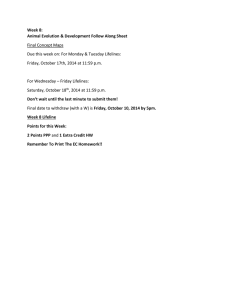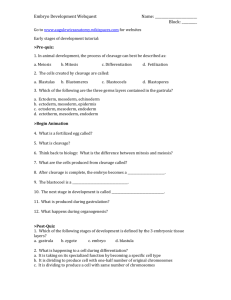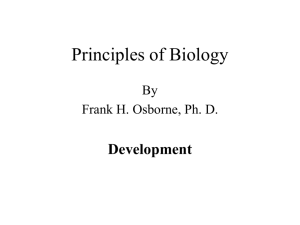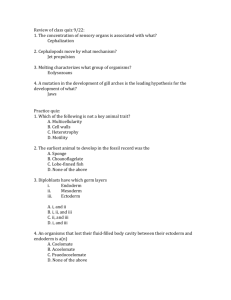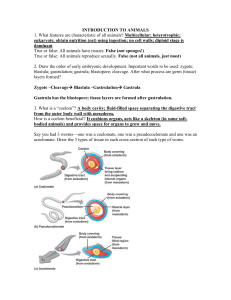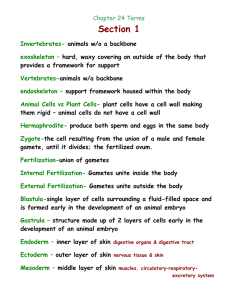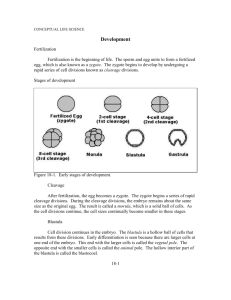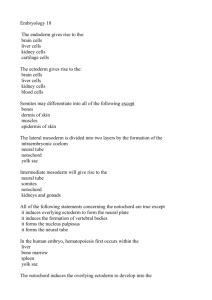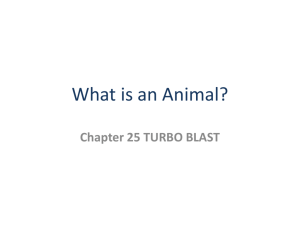INTRO to ANIMALIA PPT
advertisement
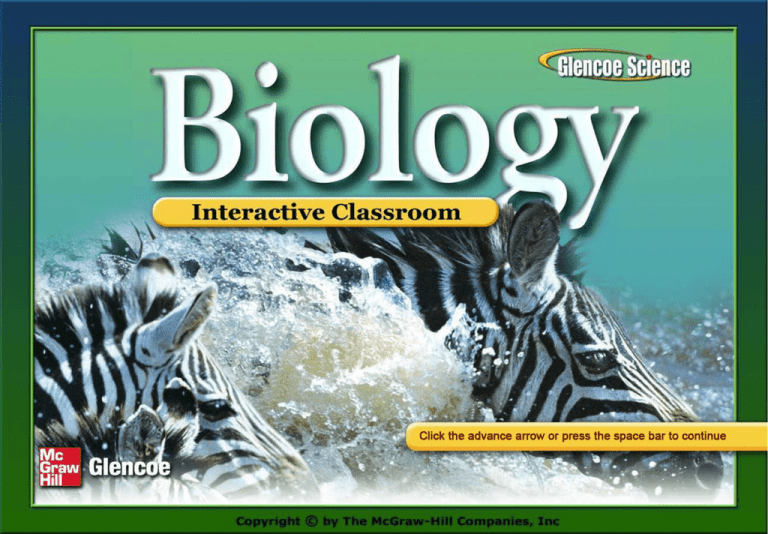
Chapter 24 Introduction to Animals Section 1: Animal Characteristics Section 2: Animal Body Plans Click on a lesson name to select. Chapter 24 Introduction to Animals 24.1 Animal Characteristics Animal Features The ancestral animals at the beginning of the evolutionary tree are eukaryotic and multicellular. Adaptive Radiation • They developed adaptations in structure that enabled them to function in numerous habitats. Chapter 24 Introduction to Animals 24.1 Animal Characteristics Feeding and Digestion Animals are heterotrophic. The structure or form of an animal’s mouth parts determines how its mouth functions. Chapter 24 Introduction to Animals 24.1 Animal Characteristics Support Invertebrates Exoskeletons Hard or tough outer coverings that provide a framework of support Protect soft body tissues Provide protection from predators Chapter 24 Introduction to Animals 24.1 Animal Characteristics Support Vertebrates Endoskeletons Protect internal organs Provide support for the body Provide an internal brace for muscles to pull against Chapter 24 Introduction to Animals Movement The evolution of nerve and muscle tissues enables animals to move in ways that are more complex and faster than organisms in other kingdoms. Chapter 24 Introduction to Animals 24.1 Animal Characteristics Reproduction Fertilization occurs when the sperm penetrates the egg to form a fertilized egg cell called the zygote. Internal fertilization External fertilization Chapter 24 Introduction to Animals 24.1 Animal Characteristics Asexual reproduction means that a single parent produces offspring that are genetically identical to itself. Budding Fragmentation Regeneration Parthenogenesis Chapter 24 Introduction to Animals 24.1 Animal Characteristics Early Development The zygote undergoes mitosis and a series of cell divisions to form new cells. The cells continue to divide, forming a fluidfilled ball of cells called the blastula. The blastula continues to undergo cell division as some cells move inward to form a gastrula. Chapter 24 Introduction to Animals 24.1 Animal Characteristics Cell Differentiation in Animal Development Chapter 24 Introduction to Animals 24.1 Animal Characteristics Tissue Development Endoderm inner layer of cells in the gastrula Ectoderm outer layer of cells in the gastrula Mesoderm layer of cells between the endoderm and ectoderm Chapter 24 Introduction to Animals 24.1 Animal Characteristics Chapter 24 Introduction to Animals 24.2 Animal Body Plans Evolution of Animal Body Plans Anatomical features in animals’ body plans mark the branching points on the evolutionary tree. Relationships on this tree are inferred by studying similarities in embryological development and shared anatomical features. Chapter 24 Introduction to Animals 24.2 Animal Body Plans Chapter 24 Introduction to Animals 24.2 Animal Body Plans Symmetry Similarity or balance among body structures of organisms Asymmetry Radial symmetry Bilateral symmetry Chapter 24 Introduction to Animals 24.2 Animal Body Plans Cephalization The tendency to concentrate nervous tissue and sensory organs at the anterior end of the animal Chapter 24 Introduction to Animals 24.2 Animal Body Plans Body Cavities Coelomates Have a fluidfilled cavity with tissue formed from mesoderm that lines and encloses the organs in the coelom Chapter 24 Introduction to Animals 24.2 Animal Body Plans Body Cavities Pseudocoelomates Have a fluid-filled body cavity that develops between the mesoderm and the endoderm rather than developing entirely within the mesoderm Chapter 24 Introduction to Animals 24.2 Animal Body Plans Body Cavities Acoelomates Have solid bodies without a fluid-filled body cavity between the gut and the body wall Chapter 24 Introduction to Animals 24.2 Animal Body Plans Development in Coelomate Animals Protostomes The mouth develops from the first opening in the gastrula. Deuterostomes The anus develops from the first opening in the gastrula. Visualizing Protostomes and Deuterostomes Chapter 24 Introduction to Animals 24.2 Animal Body Plans Segmentation Segmented animals can be “put together” from a succession of similar parts. Can survive damage to one segment Movement is more effective Segmentation! Michel Angelo’s David
